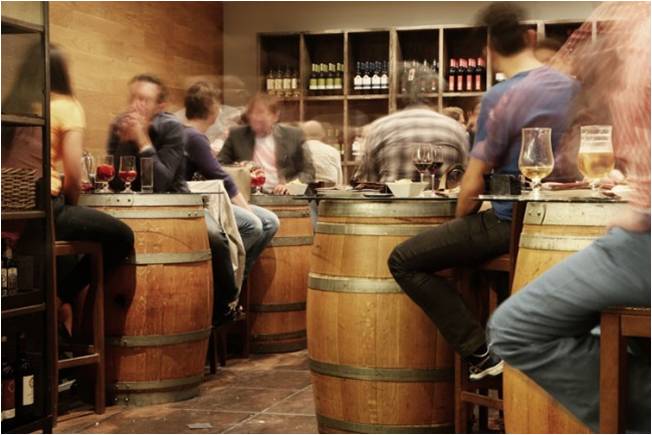10 Mobile Applications for Your Growing Restaurant
20 Apr, 2015 | Tags: apps, business, restaurant, small business, startup, technology, tools
Mobile app technology is growing exponentially and the tools available at your disposal are becoming harder to filter out. With numerous applications that serve the same function, it becomes a tiresome exercise made up of 2 key questions: 1. Which tool is best? and 2. Do we really even need this?
There is no general right answer for any of these questions. Each business and restaurant will have different sizes, customers, and objectives so it’s futile to define who needs what. With this list we provide a basic overview of several online and mobile applications that are designed to make life easier as a restaurant owner.
If any of our suggestions make you think “Hey, this would really help us out a lot”, then go check it out. Make sure you search for and compare between similar applications so you can properly decide which one is right for you.
1. The Suggestion Box– If your establishment is already using table technology to make payments and take orders, this app is a great add on to let customers provide anonymous reviews and ratings of their overall customer experience.
2. Accupos– If you are just getting started and are looking for a point of sale system, AccuPOS might be the right place to start looking. It integrates cleanly with Quickbooks and it’s scaleable design allows you to add-on tools like magnetic card readers, touchscreen pc’s and receipt printers.
3. Appsuite- Appsuite is a restaurant loyalty and reward program software that tracks your customer’s order history and “behavior”. It allows you to customize loyalty programs based on what the customer has purchased in the past.
4. Canvas– Canvas is a great tool for any kind of business that needs proper tracking of inventory, cleaning supplies, restaurant inventory, employee time sheets, etc. It also works together with Spreadsheet Processors and Quickbooks.
5. Ezee menu- When a customer is making a decision on wether to visit your restaurant or not, a well made menu goes a long way in drawing them in. With the prevalence of mobile devices, it is important to have digital version of your menus available online. Sometimes the restaurant that a customer ends up choosing is the one whose menu loaded quicker on their phone.
6. What Time do I Work– This one is our favorite for no specific reason. If you are tired of employee scheduling conflicts and the internal communication issues that come along with it, then this might be the app for you. Not only does it offer clean scheduling options, but it allows you to contact your entire staff, handle employee request, and manage employee alerts with just a few clicks.
7. Gopago– Gopago makes a heavy promise by stating it is “Everything you need to get your business up and running”. It certainly offers many tools, among them being credit card processing, cloud storage, loyalty programs, invoicing systems, and mobile ordering.
8. Nowaitapp- The nowait app makes life easier for your employees as well as your customers. Your customers can hold a place online before ever arriving to your location. It is a real time wait list and seating tool for restaurants that allow your hosts and customers to see where they are in the wait list.
9. Chownow.com– Chownow is a web app that allows you to take orders online. This obviously allows you to digitize your menu as well. If your restaurant is located near office business centers, it will greatly facilitate patrons to place their orders while they are at work so that they are ready for pickup by lunch time.
10. Uncorkd – Uncorkd is a wine and beverage menu app that lets you go the extra mile whith your wine menu. You can provide extensive information on the wines you offer, even allowing you to offer pairing suggestions and options.
These are just a few of the thousands of tools available at your disposal. Some of these might be useful for you. It’s always a wise idea to research all your options before deciding on one particular choice.
The Extra Step: How To Best Your Competitors’ Marketing Efforts
16 Apr, 2015 |
You can do your business as well as the next guy, cover all your basis, put out a quality product and provide your customers with premium service, but ultimately you will come to the conclusion that what you’ve been told is 100% true – marketing matters. A lot.
You may like it or hate it, but one thing you can be sure of is that your competitors are doing everything within their means to separate themselves from the pack and establish themselves as the golden standard within their market/community. Today more than ever marketing is an integral part of any quality business plan, and just as much as you care about the standard of your service you need to make sure that your marketing efforts are up to par.
Of course, there are only 24 hours in a day, and money is always tight, but neglecting the promotional aspect of your business is one sure way to bury it into the ground. Make peace with the fact that it is necessary, and set about doing it the best possible way.
Know your competition
Marketing is a game you play to win, and grabbing your share of the market is not going to be easy. If you wish to overcome your competitors, you will need to pay close attention to what they are doing. Take note of what they are doing right, and also try to seek out anything they might be doing wrong. In this day and age promotion is conducted on many diverse levels, from your visual identity and overall message to choosing the channels over which you will spread it. Let’s take a look at each of those aspects.
The Identity of Your Brand
Try to think about the specific qualities of your business. What type of cuisine dominates your menu? What type of “atmosphere” are you going for (think “modern”, “traditional”, “homely”, “innovative”, etc.)? What type of clientele do you envision (young, older, families, business people…)? Even if you’re a general, all around restaurant, you still need to find your niche and position yourself as a unique entity on the market. Catering to “everyone” simply won’t cut it.
Once you find the answers to those questions (and many more we have neglected to ask) you have to streamline everything – from your logo to the interiors with all of their elements – into a clear and striking package that reflects your core values and intentions. All the elements need to fall in line to form an identity that is clearly positioned on the market.
Brand loyalty
The key to attracting customers is filling a gap on the market. The key to maintaining them is meeting, and hopefully exceeding their expectations. Your primary focus is and should be the quality of your product and your service. Basically, do your job and you have yourself a nice starting platform.
There are many things businesses can do to solidify their brand, but ultimately it comes down to sending a positive message to the community. Whether it’s aligning yourself with other successful and respectable businesses, taking an active part in the community through carefully selected sponsorships (think supporting a local sports team or sponsoring a young talent), charitable work or community events. Think about what you believe in and what you’re passionate about, and whichever choice you make do your best to let the public know all about your activities.
Advertising
No revolutionary advice here. Formulating a marketing strategy is largely dependant on the specific nature of your business as well as the market in which you operate, and there are no universal rules here. Assuming your competitors are doing their job, you will need to find a way to stand out. You need to give your potential clients a specific reason to come to you and not your competitors. Identify (or create) a quality that separates you from the pack, and insist on it. Don’t be afraid to be daring and let your voice be heard, just make sure that your message is consistent with the overall image you are trying to achieve.
Feedback
Online presence is a two way street. Having a functional website and being active across social network is important not because “you don’t exist if you’re not online” (or any other empty cliche being passed around these days), but because it provides you with a direct channel of communication with a large audience. Your present and future customers can do a lot of your work for you simply by pointing out what you’re getting right, and what you could improve. Therefore, giving them a platform to provide you with feedback is simply essential. Make sure that you’re website is “user-friendly”, and if you don’t possess the necessary know how find professionals to provide you with a striking and functional web design. Be present on the social networks and try to devise creative ways to engage the community. At the least, keep them updated on all your activities
Besting your competitor’s promotional efforts is often all about covering all the bases. Essentially, if the quality of your product and your service is up to par, if you have a clear vision of what your business represents, if you utilize the things that come for free (i.e., social networks) and formulate your marketing strategy with regards to the specific nature of your desired clientele, chances are you’re good to go.
Online Matters, Offline is Essential: Marketing Your Restaurant
15 Apr, 2015 |
Most of the marketing experts out there will tell you that, if you want to succeed in today’s world, you need to pay attention to your online presence. And this is as true today as it will be tomorrow – social marketing and putting efforts into building your online social networking profile will get you a long way in approaching potential customers.
There are, however, certain industries in which online presence is simply not enough to make a difference, especially if you would like to reach maximum visibility of your product or service. This applies mostly to service industries in which live communication with clients is the most important ingredient of success, such as catering industry (restaurants), tourism and hotel business.
In this article, we will pay special attention to restaurant marketing and try to give a couple of useful pointers on how to plan your marketing strategy if you are a restaurant owner.
Online Marketing
 No talk about marketing strategy would be complete without taking at least a brief look at the much lauded online marketing, so let’s get it out of the way first.
No talk about marketing strategy would be complete without taking at least a brief look at the much lauded online marketing, so let’s get it out of the way first.
A restaurant is a place where people go not just to eat and drink, but, perhaps more importantly, to socialize. This is why some sort of presence on all major social networks is a must. Facebook, Twitter, Google Plus – these are the “places” where people meet to discuss where to go and eat next, and if you are not around for them to check you out when they make their plans, you will hardly even be considered. It is also recommended that you search for and create your profile on niche websites which offer people opportunity to rate their favorite places to eat and drink. Of course, your success on those websites will depend on your service (so you need to manage day to day tasks efficiently, What time do I work can help you with that), so make sure you have something good to offer before you get into marketing.
Promotional material
Let us now direct our attention to the “real world” and see what’s to be done if you want your restaurant to be talked about. One of the greatest ways of advertising your place is creating custom promotional products. Pens, post-its, planners, and more original things like stress balls or Rubik’s cubes with your brand name on them can go a long way in increasing your visibility on the market. These are the things your business partners will always love to have, but the best thing is that, as a restaurant, you have customers ready to promote your business as well. Every little thing your customers come into contact with can be a promotional product, and if they decide to carry that branded sip straw or a stirrer home with them, the benefits for you are obvious.
Newspapers and magazines
Despite what you think if you are one of those tech savvy people who forgot what paper looks like, people still read newspapers and magazines. Paying for advertisements in the press is always an option, but there are other ways to appear on those pages. Probably the best of them is to be a useful and contributing member of the community. This way you will both be doing good to the people of your town/city (which is a reward in itself) and to yourself and your reputation. If, say, your restaurant decides to prepare meals once a week for homeless people, this idea is sure to attract attention of local journalists who will write about you and promote your business for free.
Event hosting
 Hosting events like conferences (if you own a big restaurant) or book readings and lounge music gigs (if your restaurant is small) is always a good idea because anywhere the event is promoted, your restaurant will be mentioned as well. You will be able to attract some people who would otherwise never consider visiting your restaurant and, if you offer them good service and pleasant atmosphere, there is a possibility you will be able to turn them into regulars.
Hosting events like conferences (if you own a big restaurant) or book readings and lounge music gigs (if your restaurant is small) is always a good idea because anywhere the event is promoted, your restaurant will be mentioned as well. You will be able to attract some people who would otherwise never consider visiting your restaurant and, if you offer them good service and pleasant atmosphere, there is a possibility you will be able to turn them into regulars.
—-
Ariel Bellamy is a curious and open-minded thinker – finding solutions where needed and writing them when needed. She hopes to be an inspiring online voice one day, so follow her on the way there – on @BellamyAriel
Social Media Primer for New Business Owners (Part 2)
13 Apr, 2015 |
In our Social Media Part One post, we suggested three essential networks to join when launching a new business.
But there are hundreds of other social sites out there that you can participate in that enable you to further connect with your clientele.
How do you decide which ones to join? Are they all relevant for every business, or should you only participate in the ones most fitting for you?
We’ve added four additional social media sites for you to consider adding to your repertoire of Facebook, Twitter and Instagram. Check them out and see which ones fit best with your business’ culture.
LinkedIn is the largest business networking social media channel out there. The 332 million current members use this network to build online resumes or company profiles, connect with fellow colleagues and industry leaders, share relevant news and updates, search for jobs, apply for jobs and post jobs. Small businesses may not reap as much from this as growing businesses surely would. But advertising and company page analytics help grow your LinkedIn presence.
Pinterest is all about discovering things that interest you, in many ways like Google. While it may not seem as formal of a network as the others discussed in this list, it is entirely more engaging with over 30 billion pins to be searched. It also drives more traffic to websites than any other network. If you have anything that can be pinned and posted here (product images, artwork, DIY tutorials, recipes, blog posts, etc.) that would lead people to your website, you should pin it and watch it spread like wildfire. Check out their resources for creating a successful business page and refer to their analytics. Stay tuned as advertising opens up to the public to promote your pins.
YouTube
YouTube is the best place for business updates if videos are a part of who you are. Many a makeup artist and video gamer have become famous millionaires by enabling monetization (ads) on their videos and engaging enough viewers. While a company YouTube page would likely be more interested in sharing updates and growing a fan base, it is evidence of how influential a channel can be if it reaches even a handful of the network’s 1 billion monthly active users. Advertising on the platform is also a great way to spread awareness of your brand.
Yelp
Yelp is essential for local businesses. It enables users to search for your business, learn about it, rate and review it. While it may be daunting that this network largely relies on the unpredictable feedback from Yelp’s 135 million monthly active users, it is a go-to source for customers to check out a business before they even stop by. Fortunately, page owners can interact with Yelpers that review them and respond to questions or requests for better customer service. Advertising is available as well as customer analytics.
All of these social media networks may not work for your company and, ultimately, it’s up to you to decide which ones to join. Whatever your choice, make sure you are willing to update them regularly and keep the content diversified and interesting.
Social Media Primer for New Business Owners (Part 1)
09 Apr, 2015 |
Social media has become one of the primary means of business marketing today. It’s the best way to reach and expand a local or global audience, and it’s free. While social media sites were once strictly a place for social interactions between friends and family, nowadays they are used to create personalities for businesses and help engage conversations between them and their customers.
When launching a new business, it’s wise to simultaneously launch basic social media profiles to develop an online presence. Below is a list we’ve compiled that make up a “Social Media Starter Kit” for new businesses. Take a look at the biggest networks out there, and check back for a Social Media Part Two post for how to further connect with your clientele.
The Absolute Basics
Facebook – Facebook is a staple. With over 1.39 billion monthly active users, it’s obvious that this is where the majority of social media participants are. If you don’t have a Facebook Business Page, it’s almost as bad as not having a website – no one knows where to find you. Take advantage of all the tools Facebook gives by promoting your page via advertising, connecting other social media apps like Instagram to your page, and even learn who your fans are with page insights.
Twitter – While Twitter isn’t as populated as Facebook with 288 million monthly active users, there is more activity with 500 million tweets going out a day. Twitter messaging is different than Facebook because each tweet is limited to 140 characters, including links, pictures and hashtags. Hashtags, using the # sign in front of letter symbols, began in Twitter as a means to track trending conversations. This works well for businesses that share live event updates and announcements or want to launch a campaign/promotion for others to join in on. If you’d like to boost engagement with your Twitter profile, they have advertising as well as analytics.
Instagram – This is first and foremost a mobile-based social media network. With very limited desktop accessibility, Instagram’s 300 million monthly active users strictly share photo and 15-second video updates through smart phones via an app. This is perfect for businesses that are image-centric or visual by nature and want to share the look-and-feel culture behind their organization. The use of geotags and hashtags enable users to search content from a certain place, event, contest or theme. Editing features in the app allow users to tweak posts before posting. The recent introduction of Instagram ads may also allow more businesses to participate in the future.
These three social media networks will help you get off to a great start online. Depending on your business, there are numerous campaigns, special offers, and contests that can be used to start leveraging these platforms to build your customer base. As you start sharing, make sure that you post exciting content. Include pictures, videos, links and/or hashtags in the majority of your posts as type-only content isn’t eye-catching. Now get out there and engage in conversations and community!





